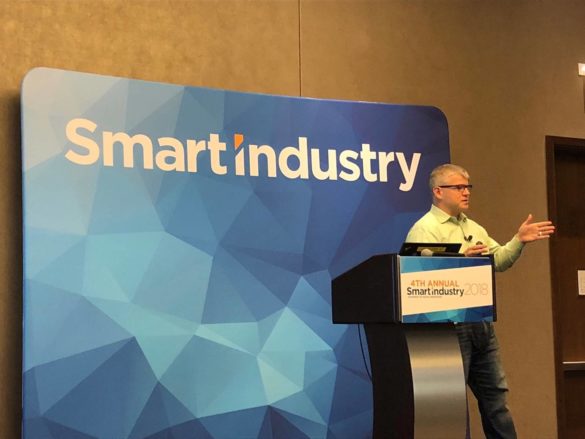As we end a wonderful and productive year for Stratus Technologies, we are reminded of some of the exciting events we’ve attended that’s made 2018 worthwhile. One was the 4th annual Smart Industry conference in Chicago, IL in late September.
In one session after another, presenters pointed out the need for massive implementations of reliable IIoT solutions to increase workforce productivity. Check out an overview from some of the Smart Industry 2018 presentations below:

Jason Anderson, Stratus Technologies, VP of Business LineManagement
In his keynote presentation at Smart Industry 2018, Jason discussed how the IIoT offers huge potential to solve the heightened complexity of industrial computing as the landscape becomes more digitized.
As the IIoT gains momentum, edge computing will play a key role in keeping manufacturers competitive in the face of mounting pressures, including the need for real-time decision making and greater levels of efficiency, productivity and quality. Stratus is responding to this demand with products such as their ztC Edge, which provides a redundant computing platform that can be installed and maintained by OT personnel.
Note many operations rely on outdated production systems that are expensive and unrealistic to replace all at once. Jason pulled from his years of expertise in IIoT and edge computing deployments to share how taking steps like investing in virtualization, emphasizing interoperability and prioritizing a simple yet powerful edge infrastructure will help manufacturers be successful in their digital transformation efforts, leading to greater value across their operations.
Arnold Martin, Center of Technical Expertise for Air Liquide, Director of Process Control Technology
In another well-attended session at Smart Industry 2018, Arnold “Marty” Martin, spoke of the need to transform their thousands of manned installations to unmanned operation. This can only be done by collecting data at the edge and making it instantly available to Air Liquide’s OT experts worldwide. “The gases we produce are essential to their operations,” Martin said. “If we sneeze they get a cold.”
Digitalization underlies all of these strategic imperatives, and Martin is currently charged with modernizing and standardizing the automation approach used in its “many mini” production facilities that currently use a hodge-podge of automation platforms deployed and acquired over the years. In his presentation, he discussed how the company is leveraging technologies such as virtualization, advanced process control, procedural automation, predictive analytics, asset performance management and remote monitoring to boost performance and increase reliability. “We are positioning ourselves to be able to use our data better—without breaking the bank,” summed up Martin.
Rolf Paeper, Ingersoll Rand’s, VP of Product Management and Digital Solutions
How does one cope with a predicted shortage of 85 million high- and medium-skilled workers globally by 2020? According to Paeper, manufacturers are finding it difficult to attract full-time technicians to ensure plant reliability. Industrial companies are instead seeking new ways to avoid production interruptions, predict preventive maintenance requirements and ensure facility uptime to maximize the bottom line.
Paeper discussed how remote monitoring digital technology can help identify plant maintenance issues and get greater uptime in facilities. He also talked about Ingersoll Rand’s journey in developing these digital technologies and showed how the company identified remote monitoring as a critical business opportunity based on its customers’ needs.
These types of issues and trends demand greater workforce productivity, which can be addressed by implementing reliable IIoT technologies. This will require the removal of complexity from availability such that implementation can be primarily accomplished by OT personnel, with assistance as required by IT.
Stratus Leads the Pack
The theme of the conference was how to make it feasible for OT personnel to design, install and maintain the IT components and systems required for IIoT implementations. This fits well with the Stratus goal of preventing business applications from failure by removing the complexity from availability. Stratus does this by providing high availability systems, often in redundant configurations, to ensure the highest level of reliability.
To determine which edge computing solution is right for your project, check out Stratus’s selector tool for a recommended solution.
[sc name=”Edge_Computing_CTA_2″]